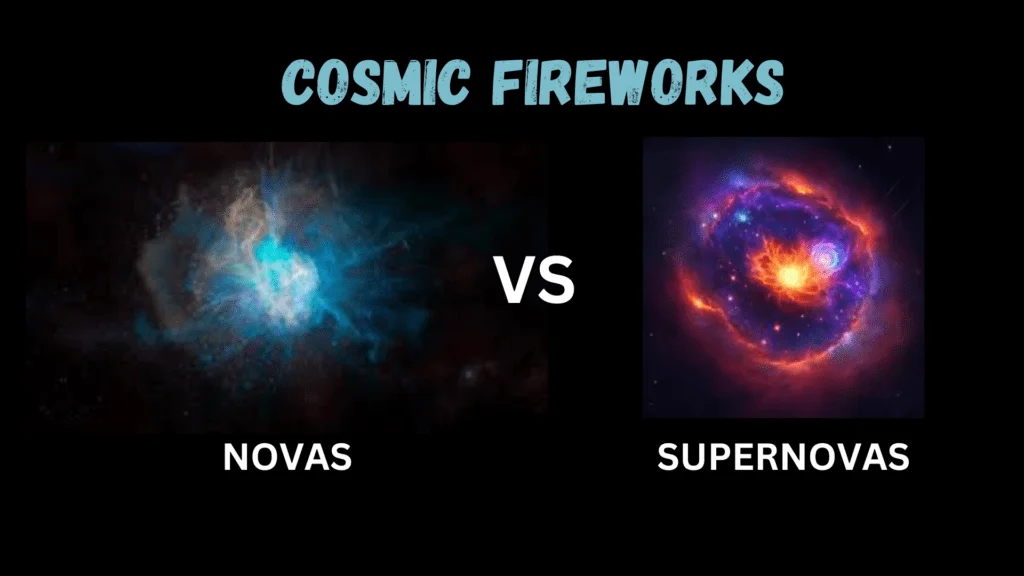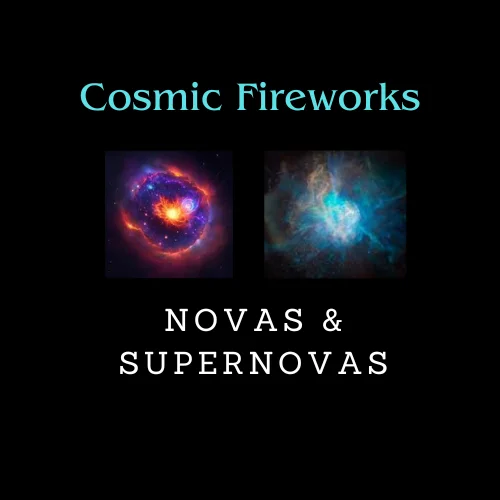You gaze up at the night sky, enthralled by the dazzling celestial light shown before your eyes. Explosions of unimaginable power are unfolding across the inky blackness of space, releasing energies that dwarf anything witnessed on Earth. These cataclysmic eruptions are no mere firecrackers but represent the grand finale of massive dying stars or the sudden flare of a white dwarf stealing matter from its companion. Welcome to the explosive universe of novas and supernovas, a realm of cosmic violence and creation where new elements are forged and scattered into the void. Peer into this fiery crucible with us as we explore the mechanisms behind these detonations that outshine entire galaxies, seed interstellar space with the building blocks of life, and fade into scenic nebulae of unparalleled beauty. The night holds untold wonders if you know where to look.
What Are Novas and Supernovas?
Novas and supernovas are stellar explosions that occur during a star’s evolution. A nova is a thermonuclear explosion on the surface of a white dwarf star that causes a sudden brightening of the star. Novas are triggered by the accretion of hydrogen onto the surface of a white dwarf from a companion star. As the hydrogen builds up, it undergoes fusion and explodes. Novas release enormous amounts of energy for a short time.
In contrast, a supernova is the explosion of an entire star. It is the largest explosion that takes place in space. Supernovas mark the death of a star and the ejection of most of its material. There are two types of supernovae: supernovae from white dwarfs (type Ia) and core-collapse supernovae (types Ib, Ic and II). Type Ia supernovae occur when a white dwarf accumulates material from a companion star until it reaches a limit and explodes. Core-collapse supernovae are caused by the collapse and subsequent explosion of a massive star at the end of its life.

Novas and supernovae are important astronomical events that produce many heavy elements, trigger star formation, and shape galactic structure. By studying them, astronomers gain insights into physics at extreme densities and temperatures, as well as a better understanding of the origins of our universe.
The Life Cycle of Stars and Stellar Explosions
To understand stellar explosions, you must first comprehend the life cycle of stars. As stars age, they expand into red giants or supergiants. Once a star has fused most of its hydrogen into heavier elements, its core collapses while the outer layers expand dramatically.
For smaller stars like our Sun, the red giant phase ends in a planetary nebula – the outer atmosphere is ejected, exposing the hot core which ionizes the gas. Medium-sized stars experience a more energetic event known as a nova, in which a white dwarf accumulates matter from a companion star until it erupts in a thermonuclear explosion that briefly brightens the star.
The most spectacular explosions are supernovae, which mark the deaths of massive stars. As the star’s core collapses into a neutron star or black hole, the overlying material rebounds and is blasted outward at high speeds. A supernova can radiate as much energy in a few months as the Sun will in its entire lifetime. The exploded star leaves behind an expanding remnant of gas and dust enriched with heavy elements that eventually condense into new stars and planets.
Stellar explosions thus play a vital role in recycling matter and chemicals in the universe. By studying them with advanced technologies like the Hubble Space Telescope, astronomers gain insights into star formation, galaxy evolution, and the origins of the elements necessary for life. Cosmic fireworks illuminate the circle of stellar life and death that has shaped the universe for billions of years.
Famous Supernovas Throughout History
Some of the most famous supernovas observed throughout history include:
SN 1006
Occurred in 1006 AD and was observed by astronomers in Africa, Europe, and China. At its peak, it was visible during the daytime and at night for several weeks. Today, the remnant of SN 1006 is the brightest radio source in the sky.
SN 1572 (Tycho’s Supernova)
Occurred in 1572 and was observed by Danish astronomer Tycho Brahe. At the time, its appearance was interpreted as an omen or portent. Today, it is known as a Type Ia supernova. The remnant of this supernova continues to expand and interact with the interstellar medium.
SN 1604 (Kepler’s Supernova)
Occurred in 1604 and was observed by Johannes Kepler. Like Tycho’s supernova, its appearance was also thought to hold symbolic meaning. Kepler’s supernova is also classified as a Type Ia supernova. Its remnant has been studied across the electromagnetic spectrum, from radio to gamma rays.
SN 1987A
Occurred in 1987 in the Large Magellanic Cloud, a satellite galaxy of the Milky Way. It was the closest observed supernova since the invention of the telescope. SN 1987A has been pivotal to studying the physics of supernovae and has transformed our understanding of these cosmic explosions. Its remnant continues to be monitored and provides insights into stellar evolution and the creation of heavy elements.
These historic supernovas have been instrumental in advancing our knowledge of astronomy, physics, and the life cycle of stars. By observing their remnants today, we gain a glimpse into the forces that shaped our universe and continue to drive its evolution.
Live Planet Distance Calculator:
The Effects of Supernovas on Surrounding Space
Supernovas have an enormous impact on the interstellar medium and space around them. When a massive star explodes as a supernova, it ejects the outer layers of the star into space at high speeds. This ejected material, known as supernova remnants, slams into surrounding gas and dust, compressing and heating it.
The shock waves from the supernova can accelerate particles to extremely high energies, producing cosmic rays. These high-energy particles then stream out into space, some eventually reaching Earth and other planets. Supernova remnants are also responsible for producing and dispersing many of the heavy elements necessary for life, seeding them throughout the galaxy.
As the supernova remnant expands, it sweeps up more and more interstellar material. This can trigger the collapse of dense clumps of gas and dust within the remnant, resulting in the formation of new stars. The extreme heat and compression within the remnant also cause the emission of X-rays for thousands of years after the initial explosion.
The effects of supernovas on space are critical for galactic evolution and the development of life itself. Without these titanic explosions dispersing heavy elements and triggering star formation, galaxies would be devoid of many elements necessary for life and lack subsequent generations of stars. Supernovas are essential for the cycle of stellar birth and death in the universe.
Observing Novas and Supernovas From Earth
As celestial fireworks shows, novas and supernovas can be observed from Earth using telescopes. To observe a nova, you will need at minimum a small telescope with an aperture of at least 6 to 8 inches. Larger telescopes, especially those in observatories, will allow for more detailed observations.
To find a nova, regularly scan the sky, especially areas with high concentrations of stars like the Andromeda Galaxy and Orion Nebula. Look for a “new star” that was not visible before. The new star may be brighter than surrounding stars. Track its brightness over time to confirm it’s a nova.
For a supernova, the new star will be much brighter, sometimes outshining all other stars in that region of sky. Supernovas tend to fade over weeks or months, so continued observations will show the decrease in luminosity. Some famous supernovas, like SN 1604 (Kepler’s Supernova) and SN 1987A, were bright enough to see with the naked eye.
Astronomers can analyze the light from a nova or supernova to determine characteristics like temperature, composition, and motion. As the explosion fades, the gaseous remnants can also be studied. These observations provide insights into stellar evolution and the origins of elements scattered into space.
Though relatively rare, witnessing a nova or supernova event can be a thrilling experience for an amateur astronomer. With patience and persistence in scanning the night sky, you may be fortunate enough to observe one of these spectacular cosmic fireworks shows.
Cosmic Significance of Supernovas
Supernovas are some of the most energetic and luminous events in the universe. As massive stars reach the end of their lifespan, they explode in a burst of light and heavy elements that seed the universe.
The Life and Death of Massive Stars
The life cycle of massive stars typically ends in a supernova explosion. As the star fuses lighter elements into heavier ones, it builds up an onion-like layer of elements around an iron core. Once the core is mostly iron, fusion stops and the star collapses under its own gravity. The resulting supernova scatters the outer layers of the star, releasing an intense burst of light and radiation.
Element Creation and Dispersal
The extreme heat and pressure of supernovas create many of the heavy elements necessary for life and technology. Elements like carbon, oxygen, calcium, and iron are fused together and scattered into space. As supernova remnants expand, they enrich surrounding interstellar gas and dust with these heavy elements. Future generations of stars and their planetary systems form from this enriched medium. In a very real sense, we are made of stardust from ancient supernovae.
Cosmic Recycling
Supernovas do more than create elements – they also recycle material and energy in the universe. As massive stars end their lives, they return their raw materials and convert gravitational potential energy into light, heat, and the kinetic energy of the expanding supernova remnant. This energy helps power galactic ecosystems and the next generation of star formation. In death, massive stars give new life to the cosmos in an endless cycle of stellar renewal.
Supernovas are some of the most spectacular displays of nature’s destructive and creative powers. Although fleeting, their influence on the universe is profound and eternal. By scattering the ashes of dead stars, they light the way for new life.
Novas and Supernovas in Astrophysical Research
Novas and supernovas are some of the most energetic events in the universe. When studying these cosmic fireworks, astrophysicists gain insights into stellar evolution, nucleosynthesis, and the expansion of the universe.
Novas
A nova occurs when a white dwarf gravitationally pulls material from a companion star onto its surface, compressing and heating the accreted gas. When the temperature and pressure become high enough, runaway nuclear fusion causes a thermonuclear explosion that ejects much of the star’s mass into space. Novae can increase in brightness by as much as 20 magnitudes in a few hours. By observing a nova’s light curve and spectra over time, researchers can determine the chemical composition of the ejected material as well as the mass of the white dwarf.
Supernovae
A supernova explosion signifies the death of a massive star. As the star runs out of fuel, its core collapses and then rebounds in a shock wave that blows apart the outer layers of the star. Supernovae are crucial for producing and dispersing into space the elements necessary for life. By analyzing supernova light curves and spectra, scientists can classify supernovae into types based on their physical properties. For example, Type Ia supernovae always have nearly the same peak luminosity, so they are used as “standard candles” to measure distances in the universe and study dark energy.
Studying these extreme stellar phenomena provides essential insights into physics, chemistry, and cosmology. Continued observations of novas and supernovas will lead to new discoveries about the workings of the universe and the origins of life itself.
Conclusion
You have now learned about the incredible cosmic fireworks known as novas and supernovas. These massive stellar explosions light up the universe, burning brighter than entire galaxies. Though fleeting, their impact is enormous. Novas and supernovas forge heavy elements, scatter them into space, and trigger the formation of new stars. They also reveal secrets about the end stages of star evolution and the ultimate fate of our universe. By studying these spectacular events, astronomers expand our understanding of physics, chemistry, and the cosmos itself. The dazzling celestial fireworks shows will continue to inspire wonder and lead us to discoveries we can only imagine today. Keep your eyes on the skies – the universe has many more explosive surprises in store.

